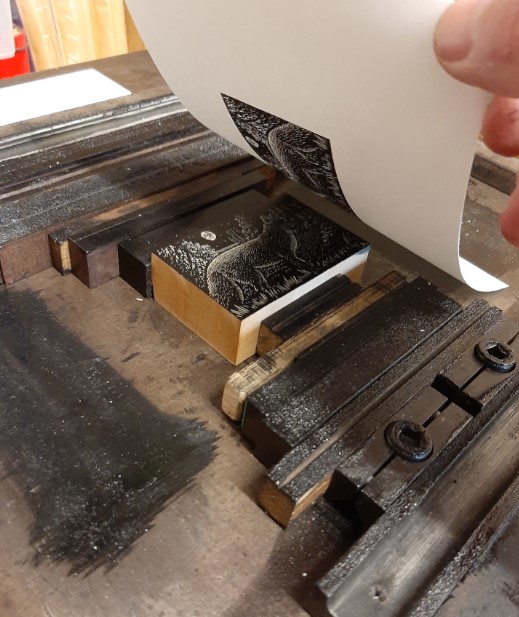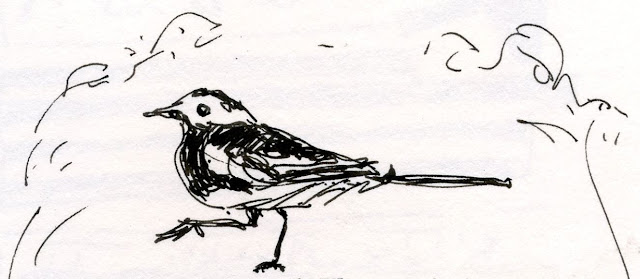Today is the 100th birthday of the Society of Wood Engravers.
Last night would have been the preview of an exhibition at the Ashmolean Museum in Oxford. I was honoured to have my engraving "Box No. 1" selected for this. Today, I would have been at my table at the Oxford Fine press Fair, with a selection of my prints and handmade books for sale, seeing friends from around the world and catching up with their new work. The pandemic has stopped all this - the Fine Press Fair has been postponed until November and I am likely to have even more new work to show!
Back to engraving and the SWE.
Becoming an engraver.
I have always enjoyed printmaking, even before I really understood that it existed as an artform.
When I was young, I loved stamps, especially Victorian ones. A penny black was beyond my means but penny reds were common and could be had with pocket money. These were the imperforate 1841 stamps like this:
I was buying word, trimmed and tatty ones but loved the look of them. Once in a while I would find a "Maltese Cross" cancellation like the one above. I loved these the most. Grouping a few of these stamps together gave me a sense of them being multiples and this idea stayed with me. I had always loved to draw and paint - I only had thin paper and poster colours but it was enough. The more I thought about groups of stamps, the more an idea formed in my mind.
I went out to the outhouse where my fathers workbench was. This was also the coal house and housed the copper. This was a metal bowl set in a brick box where my mother washed the clothes. She would light a fire under the bowl to heat the water to wash the clothes, which would then be put through the mangle and hung out. The zinc bath was here as well. This is would be carried in, placed in front of the fire and I would have my weekly bathe. If neighbours came in, they would sit either side my bathtub and talok over my disgruntled head.
At the workbench, I took some kindling from the woodpile, fixed it in the vice and planed it flat. Then I took a chisel and my pocket knife and cut a row of heads in the wood. Then I took this inside, gave the surface a good brushing of red poster paint and pressed thin paper over it, smoothing it firmly with my hands. The results were crude but I felt the first satisfaction of revealing a printed image and making multiples. I remember making many of these "stamps" but none survive, as far as I know.
I kept on drawing - small detailed draings that were usually observational. In the mid 70s, there was not an art school in the country who would have been interested in what I was doing. My first degree was in Geology and I spent three contented years making small, detailed observational drawings of rocks, minerals and, especially, fossils. Following this, I taught in a Cambridge comprehensive for 26 years - and definitely not an art teacher, although I enjoyed "covering" art lessons - especially with the Columbian handpress that sat in the art room - generally used as a coatstand!
I did continue to flirt with printmaking - particularly with lino. My work was bold and fluid but I missed the detail of my drawings. I knew about wood engraving but put it off, thinking it to be a difficult thing. Eventually, in 1991, I took the train to London to visit Lawrences. I bought some gravers, a tube of ink, some paper, a better roller and some blocks that were in a "sale" box. The long thin shapes of some of these interested me.
When I first tried wood engraving, it seemed more like remembering that learning. The small scale, detail and black and white work that I started to pruduce - burnished with smooth wood - gave me the same satidfaction of making multiples. Being a country boy and still living in a village, it is no surprise that my work was rural. It was also autobigraphical - I wanted to engrave images of the things around me. I learned from trial and error and a battered book by Benson. It turned out that a colleague at school was also an engraver - she had been taiught by John O'Connor and Blair Hughes-Stanton at the Colchester School of Art - she gave me enough technique to stop me stabbing my fingers!
Joining The SWE
I have always been self taught at most of the things I do and this was no different. That year, "Venetian Morning" was accepted and hung in the SWE annual exhibition. I signed up for a weekend course in Norfolk, led by Sarah Van Niekirk, who was then chair of the SWE. That year, and the follwing, Sarah filled in the gaps in my practical knowledge and taught me the importance of establishing the light in the block. She sold me more tools and some more blocks, including a semi-circular one that I used for "The Fossil Collectors":

After I had been included in three SWE selected shows, I was eligible to apply for membership. I sent a portfolio of prints and related drawings (yes I really had found my artistic home) and we travelled down to the annual SWE picnic. These were very enjoyable and my first chance to meet other engravers - some with huge reputations as artists but all welcoming. Hilary Paynter came to find me and told me that I had been elected. I was hugely pleased and proud to join the society.
Inside the SWE
From my point of view, the SWE could not have suited me better. The members were always welcoming and encouraging. I am always aware of being an outsider in the art world - untrained and with a tendency to make small, detailed, rural work. Inside the SWE I was accepted. I liked the gender balance within the SWE - most of the artists who influenced me were talented women with great reputations. Since then, I have had work accepted for all of the annual shows (which are all selected so it is never a given) and have sat on the committee to make such contributions as I could. I set up the first SWE website when such things were simple and have enjoyed that aspect of the society develop in more professional hands.
After over a quarter of a century, I left teaching. My school needed two teachers to take voluntary redundancy. I applied and, with great support from Joan, became an "engraver for hire". I still am!
Now
I am still very pleased to be a member. I went down to London in February for the preview of the fantastic annual touring exhibition at Bankside and saw lots of old friends. I still engrave - often commisioned work such as a bookplate, logo or some illustrations, often for Private Press books. I especually enjoy making my own handmade books - they are small, almost completely engraved, including text, and great fun to produce for my own imprint "The Isle Handpress".
So Happy Birthday SWE! A place where this art outsider found a happy artistic home.

















































